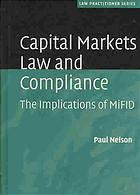
Capital markets law and compliance : the implications of MiFID PDF
Preview Capital markets law and compliance : the implications of MiFID
This page intentionally left blank Capital Markets Law and Compliance The Markets in Financial Instruments Directive (MiFID) is a detailed re-writing of the regulation of capital markets. To the extent those rules permit, the Financial Services Authority (FSA) is also introducing high-level ‘principles-based regulation’. In response to this, Paul Nelson presents practical guidance on the regulation of the capital markets, ranging from new issues and IPOs to investment banking, broker-dealing and asset management. All laws and rules relevant to the regulation of the capital markets are explained and put into context within the economic operation of markets, institutions and products, the European Single Market, the FSA’s policies and objectives, the historical evolution of the regulations and the general civil and criminal law. Drawing on 30 years’ experience as a practi- tioner, and referring to a vast range of supporting materials, the author provides an insightful analysis and critique of the rules, the rule makers and the institutions. PAUL NELSON is a partner at Linklaters, London. He is also the FINRA Professor of Capital Markets Regulation and Compliance at the ICMA Centre, University of Reading. Law Practitioner Series The Law Practitioner Seriesoffers practical guidance in corporate and commercial law for the practitioner. It offers high-quality comment and analysis rather than simply restating the legislation, providing a critical framework as well as exploring the fundamental concepts which shape the law. Books in the seriescover carefully chosen subjects of direct relevance and use to the practitioner. The series will appeal to experienced specialists in each field, but is also accessible to more junior practitioners looking to develop their understanding of particular fields of practice. The Consultant Editors and Editorial Board have outstanding expertise in the UK corporate and commercial arena, ensuring academic rigour with a practical approach. Consultant editors Charles Allen-Jones, retired senior partner of Linklaters Mr Justice David Richards, Judge of the High Court of Justice, Chancery Division Editors Chris Ashworth – O’Melveny & Myers LLP Professor Eilis Ferran – University of Cambridge Nick Gibbon –Allen & Overy Stephen Hancock – Herbert Smith Judith Hanratty –BP Corporate Lawyer, retired Keith Hyman – Clifford Chance Keith Johnston –Addleshaw Goddard Vanessa Knapp –Freshfields Bruckhaus Deringer Charles Mayo – Simmons & Simmons Andrew Peck – Linklaters Richard Snowden QC – Erskine Chambers Richard Sykes QC William Underhill – Slaughter & May Sandra Walker –Rio Tinto Books in the series Stamp Duty Land Tax Michael Thomas; Consultant Editor David Goy QC Accounting Principles for Lawyers Peter Holgate The European Company: Volume 1 General editors Dirk Van Gerven and Paul Storm Capital Markets Law and Compliance: The Implications of MiFID Paul Nelson Capital Markets Law and Compliance: The Implications of MiFID PAUL NELSON CAMBRIDGEUNIVERSITYPRESS Cambridge, New York, Melbourne, Madrid, Cape Town, Singapore, São Paulo Cambridge University Press The Edinburgh Building, Cambridge CB28RU, UK Published in the United States of America by Cambridge University Press, New York www.cambridge.org Information on this title: www.cambridge.org/9780521889360 © Cambridge University Press 2008 In the diagrams, Paul Nelson 2008 This publication is in copyright. Subject to statutory exception and to the provision of relevant collective licensing agreements, no reproduction of any part may take place without the written permission of Cambridge University Press. First published in print format 2008 ISBN-13 978-0-511-37513-2 eBook (Dawsonera) ISBN-13 978-0-521-88936-0 hardback Cambridge University Press has no responsibility for the persistence or accuracy of urls for external or third-party internet websites referred to in this publication, and does not guarantee that any content on such websites is, or will remain, accurate or appropriate. For Myrtle, Aubrey, Dora, Saul, Joel, with love and respect Contents Preface xiii List of acronyms xiv Part I Evolution of capital markets regulation, FSA and the European single market 1 1 Introduction 3 2 FSMA and the single market 8 2.1 Evolution 8 2.2 Up to the 1930s 9 2.2.1 The secondary market and the London Stock Exchange 9 2.2.2 Primary market new issues 10 2.3 The Prevention of Fraud Acts 12 2.4 The Financial Services Act 1986 15 2.4.1 Reform of securities regulation 15 2.4.2 Self-regulation? 17 2.4.3 Rules and principles 19 2.4.4 A complete (functional) regulatory regime 22 2.5 FSMA 27 2.5.1 The statutory objectives 33 2.5.2 Conveyance structure 36 2.5.3 Annual report 37 2.5.4 Practitioner input and consultation 38 2.5.5 Enforcement 39 2.5.6 Complaints commissioner 43 2.5.7 Accountability to Treasury 44 2.5.8 The rulebook 45 2.6 European Union directives 53 Part II Licensing and rule application 61 3 Licensing 63 3.1 Analysing the application of regulations 63 3.2 Regulated activities 64 vii Capital Markets Law and Compliance 3.2.1 ‘Investments’ 65 3.2.2 ‘Investment activities’ 79 3.2.3 Activities in and/or from a UK place of business 86 3.2.4 Activities into the UK and the overseas persons exclusion 86 3.2.5 Excluded activities 88 3.2.6 The ISD/MiFID override 90 3.2.7 By way of business 92 3.2.8 A licence is required 92 3.3 Process and criteria 94 3.4 Passporting 94 3.5 Non-EEA firms 96 4 The application of FSA MiFID rules 98 4.1 Methodology 98 4.2 Rules of application 98 Part III The firm’s infrastructure 111 5 Systems and controls 113 5.1 Evolution of FSA’s approach 113 5.2 Systems and controls rules 117 5.2.1 Overall requirement 118 5.2.2 Apportionment of responsibility 121 5.2.3 Control functions 123 5.2.4 Employees 125 5.2.5 Outsourcing 128 5.3 Senior management responsibility 132 5.3.1 Registration as an Approved Person 132 5.3.2 Rule responsibilities 135 5.4 Approved Persons 139 5.4.1 Registration as an Approved Person 139 5.4.2 Rule responsibilities 140 5.5 Record-keeping 140 5.6 FSA’s risk assessment methodology 142 6 Conflicts of interest 146 6.1 Differences in interests and conflicts of interest 146 6.2 The general law of fiduciaries 146 6.2.1 A fiduciary relationship 146 6.2.2 A conflict of interest 148 6.2.3 Solutions 153 6.3 Regulatory rules 158 6.3.1 The general rule 158 6.3.2 Inducements 166 6.3.3 Soft commission and bundling 171 viii
